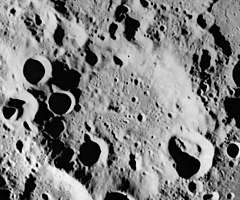Titius (crater)
Titius is a lunar impact crater that is located on the Moon's far side, beyond the eastern limb. It lies to the west of the Lacus Solitudinis, a small lunar mare. Less than a crater diameter to the north east is the crater Bowditch, and farther to the southwest is Donner.
 Apollo 15 image | |
| Coordinates | 26.8°S 100.7°E |
|---|---|
| Diameter | 73 km |
| Depth | 2.7 km |
| Colongitude | 260° at sunrise |
| Eponym | Johann D. Titius |
The rim of this crater has been nearly ruined by subsequent impacts, leaving only the northern and northeast parts relatively intact. There is a breach in the rim to the south, with the southeast overlain by Titius J and the southwest by Titius N and Titius Q, leaving only a short length of shallow, surviving rim to the south-southwest. The western rim is disrupted by three other small craters. The interior floor has some irregularities, but is relatively featureless and level to the northeast.
Satellite craters
By convention these features are identified on lunar maps by placing the letter on the side of the crater midpoint that is closest to Titius.
| Titius | Latitude | Longitude | Diameter |
|---|---|---|---|
| J | 27.6° S | 101.6° E | 24 km |
| N | 28.1° S | 100.0° E | 20 km |
| Q | 28.0° S | 98.6° E | 46 km |
| R | 27.1° S | 99.9° E | 14 km |
See also
- 1998 Titius, main-belt asteroid
References
- Andersson, L. E.; Whitaker, E. A. (1982). NASA Catalogue of Lunar Nomenclature. NASA RP-1097.CS1 maint: ref=harv (link)
- Blue, Jennifer (July 25, 2007). "Gazetteer of Planetary Nomenclature". USGS. Retrieved 2007-08-05.CS1 maint: ref=harv (link)
- Bussey, B.; Spudis, P. (2004). The Clementine Atlas of the Moon. New York: Cambridge University Press. ISBN 978-0-521-81528-4.CS1 maint: ref=harv (link)
- Cocks, Elijah E.; Cocks, Josiah C. (1995). Who's Who on the Moon: A Biographical Dictionary of Lunar Nomenclature. Tudor Publishers. ISBN 978-0-936389-27-1.CS1 maint: ref=harv (link)
- McDowell, Jonathan (July 15, 2007). "Lunar Nomenclature". Jonathan's Space Report. Retrieved 2007-10-24.CS1 maint: ref=harv (link)
- Menzel, D. H.; Minnaert, M.; Levin, B.; Dollfus, A.; Bell, B. (1971). "Report on Lunar Nomenclature by the Working Group of Commission 17 of the IAU". Space Science Reviews. 12 (2): 136–186. Bibcode:1971SSRv...12..136M. doi:10.1007/BF00171763.CS1 maint: ref=harv (link)
- Moore, Patrick (2001). On the Moon. Sterling Publishing Co. ISBN 978-0-304-35469-6.CS1 maint: ref=harv (link)
- Price, Fred W. (1988). The Moon Observer's Handbook. Cambridge University Press. ISBN 978-0-521-33500-3.CS1 maint: ref=harv (link)
- Rükl, Antonín (1990). Atlas of the Moon. Kalmbach Books. ISBN 978-0-913135-17-4.CS1 maint: ref=harv (link)
- Webb, Rev. T. W. (1962). Celestial Objects for Common Telescopes (6th revised ed.). Dover. ISBN 978-0-486-20917-3.CS1 maint: ref=harv (link)
- Whitaker, Ewen A. (1999). Mapping and Naming the Moon. Cambridge University Press. ISBN 978-0-521-62248-6.CS1 maint: ref=harv (link)
- Wlasuk, Peter T. (2000). Observing the Moon. Springer. ISBN 978-1-85233-193-1.CS1 maint: ref=harv (link)